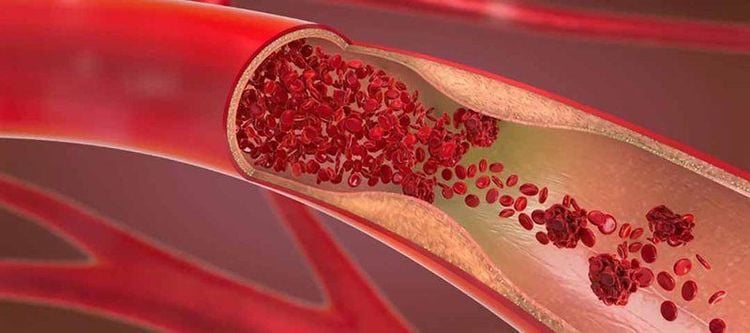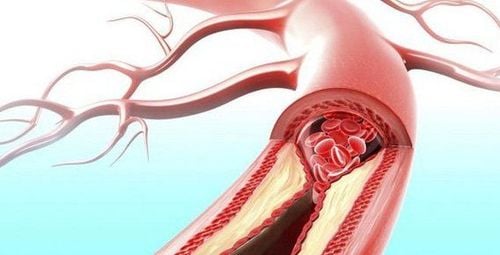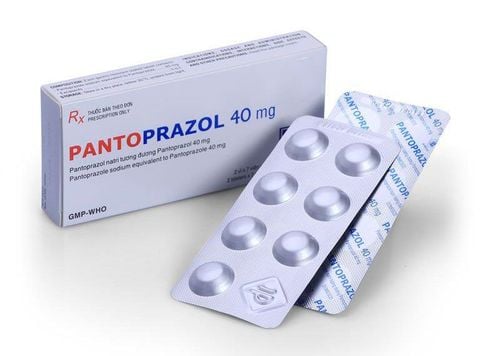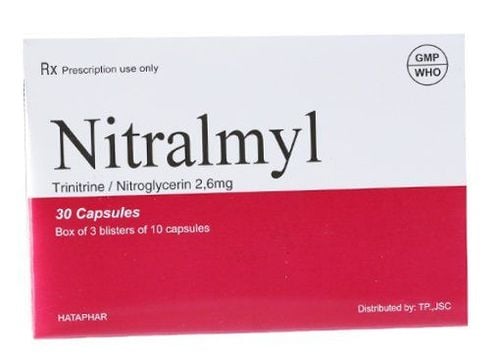This is an automatically translated article.
Renal artery thrombosis and renal embolism are vascular events occurring in the kidney. Similar to arterial thromboembolic diseases in other organs, thrombosis leading to complete renal artery occlusion will cause loss of kidney function, irreversible progression if diagnosed late and intervened incorrectly right from the start. head.1. What is renal artery thrombosis?
Renal artery thrombosis is a rare condition that can be overlooked when evaluating renal dysfunction. This is a condition in which a blood clot forms in one or both arteries that supply blood to the kidneys. The consequence of renal artery thrombosis is decreased renal perfusion and possibly renal injury or failure.Renal artery thrombosis causing renal embolism can be acute or chronic. Acute renal embolism is usually unilateral while chronic renal embolism can be bilateral.
Epidemiologically, although renal artery thrombosis is most common in the 30 to 50 population, it can actually occur at any age. In addition, there was no difference in sex or predisposition to right or left artery.
The prognosis of renal artery thrombosis and renal embolism is assessed by the size of the thrombus, duration of survival, and number of infarcts. In the event of an infarction, 8% of patients will have worsening renal function, leading to the need for dialysis treatment. However, most patients will recover rapidly to renal function once renal perfusion improves.
2. Causes of renal artery thrombosis
Potentially progressive endothelial damage leads to renal artery thrombosis and renal embolism. People with a history of atherosclerosis, blunt trauma, or renal artery stenting are all considered to be at increased risk for this condition. However, the most common cause of renal artery thrombosis is thromboembolism originating in the heart or large arteries. Of these, nearly 95% of blood clots originate in the heart. In addition, hypercoagulability is another major risk factor for renal artery thrombosis. Cancer diagnoses, frequent oral contraceptive use, and systemic inflammatory processes may also predispose to this endovascular disease. In addition, genetic conditions that increase the risk of blood clots are also important to keep in mind in the patient history. Reduced blood flow and increased blood viscosity are factors that can create situations where renal artery thrombosis and renal embolism can occur. Other causes of renal artery thrombosis may be: polycythemia vera, nephrotic syndrome, pregnancy, systemic lupus erythematosus, Ehlers-Danlos syndrome, infective endocarditis, and vascular hypertension blood. Arterial injury from surgical intervention may complicate the development of renal artery thrombosis. This includes renal angiography, intra-aortic balloon placement, kidney surgery or a kidney transplant, etc.
Huyết khối động mạch thận là biến cố mạch máu xảy ra tại thận
3. Signs of renal artery thrombosis
The manifestations of renal artery thrombosis depend on the rate of onset, extent and duration of renal hypoperfusion. Single renal artery stenosis is usually asymptomatic for a long time.Acute complete renal artery occlusion of one or both renal arteries causes episodes of low back or lower costal pain, fever, nausea, and vomiting. General hematuria, oliguria, or anuria may occur, and hypertension is rare.
After 24 hours, symptoms and signs of renal artery thrombosis due to acute kidney injury may develop. If the cause is systemic thromboembolism, features of thromboembolism at other sites (eg, blue toe, retinal lesions on endoscopic examination) may also be present.
In the case of new chronic progressive narrowing renal artery thrombosis causing signs of hypertension, it may begin at an atypical age (eg, before age 30 or after age 50). Physical examination revealed a tumor in the abdomen or signs of atherosclerosis. The symptoms and signs of chronic kidney disease are accompanied by a slow rate of progression.
4. How to diagnose renal artery thrombosis and renal embolism?
For patients with a history, risk factors, and signs pointing towards renal artery thrombosis and renal embolism, the physician should correct the study with contrast-enhanced computed tomography of the abdominal and Pelvis. In the context of trauma, this indication is often performed at the outset to screen for visceral damage.To look for etiology, echocardiography should be indicated to evaluate the possibility of cardiac occlusion. This is especially important in people with prosthetic heart valves or a history of atrial fibrillation.
Other tests that should also be done are complete blood count, urinalysis with urine culture and lactate dehydrogenase (LDH). A strong correlation with hematuria, proteinuria, elevation of aspartate aminotransferase (AST) and elevation of LDH has been observed when renal artery thrombosis and renal embolism progress to renal infarction.

Huyết khối động mạch thận có thể gây mất chức năng thận
5. Treatment of renal artery thrombosis and renal embolism
Although rare, renal artery thrombosis can be life-threatening and is often misdiagnosed. Therefore, it is important to get a correct diagnosis and immediate treatment.The first step in management is to initiate anticoagulation with heparin . Given the possible need for local thrombolytic intervention under fluorescein, enoxaparin therapy may not be appropriate. This is especially true in the context of underlying renal dysfunction. Therefore, close consultation with both the nephrologist and the interventional physician is required when anticoagulation therapy is indicated in these circumstances.
Thrombolysis may be indicated if the degree of renal artery occlusion on imaging is significant. Renal function tests, comorbidities, and imaging findings should guide treatment management. The primary concern is the prevention of renal infarction and potential sequelae. Surgical intervention should be considered in the setting of severe abdominal trauma or hemodynamic instability. If thrombosis causing renal artery occlusion has a cardiac etiology due to atrial fibrillation, the patient has a history of coagulopathy and the presence of a mechanical heart valve, long-term anticoagulation is indicated to prevent complications. future events.
6. Possible complications of renal artery thrombosis and renal embolism
Renal infarction is the main complication that can occur when renal artery thrombosis causes complete occlusion of the renal artery but is not treated or treated late. Renal infarction can lead to significant kidney failure, which in some cases may be irreversible. Dialysis therapy may be required for life if the patient already has chronic kidney disease or has impaired kidney function. In some cases, when treatment is delayed due to misdiagnosis, it often leads to irreversible kidney damage leading to nephrectomy.In addition, sometimes uncontrolled hypertension is another serious sequelae of renal artery thrombosis causing renal artery occlusion that clinicians need to be aware of and manage.
In summary, renal artery thrombosis and renal artery occlusion causing renal infarction is an acute vascular event. Therefore, in the appropriate clinical setting, renal artery thrombosis should be evaluated early with both blood tests and imaging to provide an appropriate diagnosis, prompt treatment to prevent permanent renal failure. However, the causes of renal artery thrombosis also require identification and long-term secondary prevention treatment in the future.
Please dial HOTLINE for more information or register for an appointment HERE. Download MyVinmec app to make appointments faster and to manage your bookings easily.













